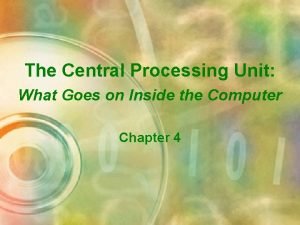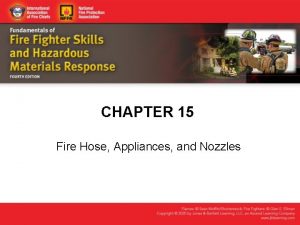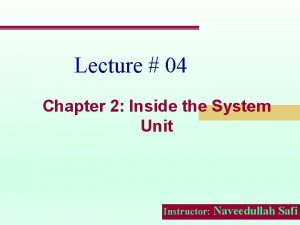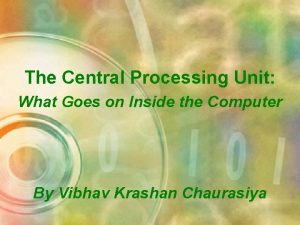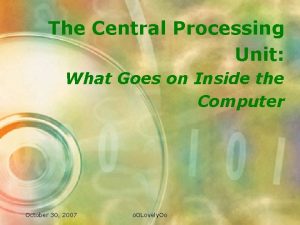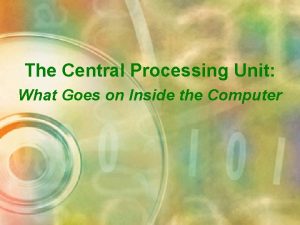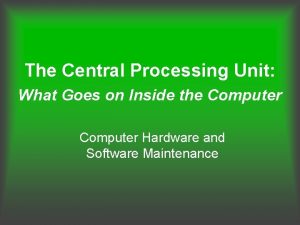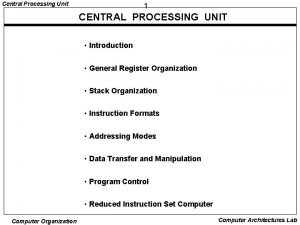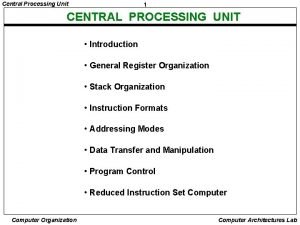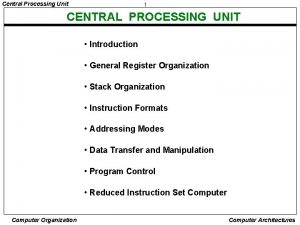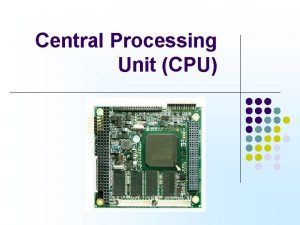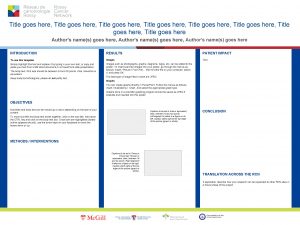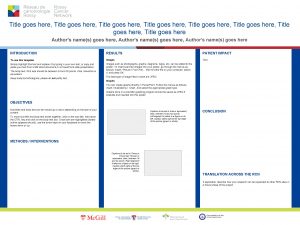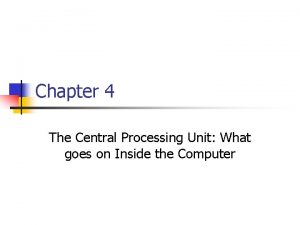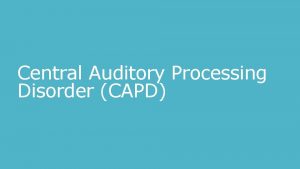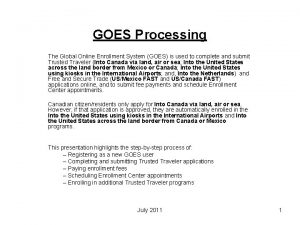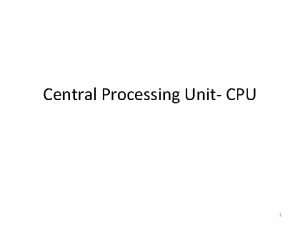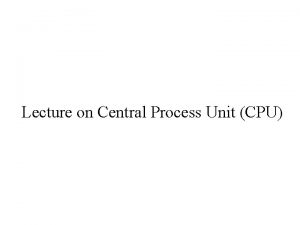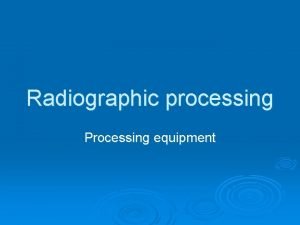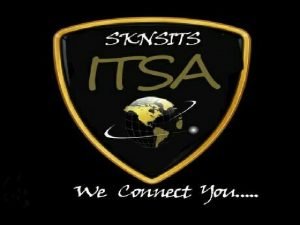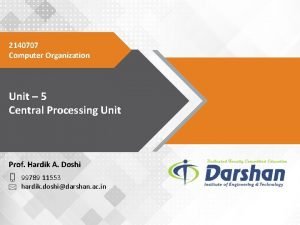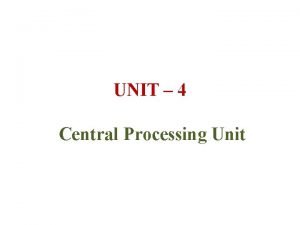The Central Processing Unit What Goes on Inside


























































- Slides: 58

The Central Processing Unit: What Goes on Inside the Computer Chapter 4

Objectives • Identify the components of the central processing unit and how they work together and interact with memory • Describe how program instructions are executed by the computer • Explain how data is represented in the computer • Describe how the computer finds instructions and data • Describe the components of a microcomputer system unit’s motherboard • List the measures of computer processing speed and explain the approaches that increase speed

Contents • The CPU • Types of Storage • Executing Programs • Finding Data in Memory • The System Unit • Microprocessor • Semiconductor Memory • Bus Line • Speed and Power

The CPU

The CPU • Converts data into information • Control center • Set of electronic circuitry that executes stored program instructions • Two parts – Control Unit (CU) – Arithmetic Logic Unit (ALU)

Control Unit CU • Part of the hardware that is in-charge • Directs the computer system to execute stored program instructions • Communicates with other parts of the hardware

Arithmetic / Logic Unit ALU Performs arithmetic operations Performs logical operations

Arithmetic Operations Addition Subtraction Multiplication Division

Logical Operations • Evaluates conditions • Makes comparisons • Can compare – Numbers – Letters – Special characters

Registers Special-purpose High-speed Temporary storage Located inside CPU Instruction register Data register Holds instruction currently being executed Holds data waiting to be processed Holds results from processing

Types of Storage • Secondary – Data that will eventually be used – Long-term • Memory – Data that will be used in the near future – Temporary – Faster access than storage • Registers – Data immediately related to the operation being executed – Faster access than memory

Measuring Storage Capacity KB – kilobyte • 1024 bytes • Some diskettes • Cache memory MB – megabyte • Million bytes • RAM GB – gigabyte • Billion bytes • Hard disks • CDs and DVDs TB – terabytes • Trillion bytes • Large hard disks

Memory Many Names Primary storage Primary memory Main storage Internal storage Main memory

Main Types of Memory RAM Random Access Memory ROM Read Only Memory

RAM • Requires current to retain values • Volatile • Data and instructions can be read and modified • Users typically refer to this type of memory

What’s in RAM? • Operating System • Program currently running • Data needed by the program • Intermediate results waiting to be output

ROM • Non-volatile • Instructions for booting the computer • Data and instructions can be read, but not modified • Instructions are typically recorded at factory

Executing Programs • CU gets an instruction and places it in memory • CU decodes the instruction • CU notifies the appropriate part of hardware to take action • Control is transferred to the appropriate part of hardware • Task is performed • Control is returned to the CU

Machine Cycle I-time • CU fetches an instruction from memory and puts it into a register • CU decodes the instruction and determines the memory location of the data required

Machine Cycle E-time • Execution – CU moves the data from memory to registers in the ALU – ALU is given control and executes the instruction – Control returns to the CU • CU stores the result of the operation in memory or in a register

System Clock • System clock produces pulses at a fixed rate • Each pulse is one Machine Cycle • One program instruction may actually be several instructions to the CPU • Each CPU instruction will take one pulse • CPU has an instruction set – instructions that it can understand process

Finding Data in Memory • Each location in memory has a unique address – Address never changes – Contents may change • Memory location can hold one instruction or piece of data • Programmers use symbolic names

Data Representation On/Off Binary number system is used to represent the state of the circuit

Bits, Bytes, Words • BIT – Binary Dig. IT – On/off circuit – 1 or 0 • BYTE – 8 bits – Store one alphanumeric character • WORD – Size of the register – Number of BITS that the CPU processes as a unit

Coding Schemes • ASCII – Uses one 8 bit byte – 28 = 256 possible combinations or characters – Virtually all PCs and many larger computers • EBCDIC – Uses one 8 bit byte – 28 =256 possible combinations or characters – Used primarily on IBM-compatible mainframes • Unicode – – Uses two 8 bit bytes (16 bits) 216 = 65, 536 possible combinations or characters Supports characters for all the world’s languages Downward-compatible with ASCII

The System Unit The Black Box • Houses electronic components – Motherboard – Storage devices – Connections • Some Apple Macintosh models have system unit inside monitor

The System Unit The Black Box Motherboard • Microprocessor chip • Memory chips • Connections to other parts of the hardware • Additional chips may be added – math coprocessor

The System Unit The Black Box Storage Devices Hard drive Floppy drive CD-ROM drive DVD-ROM drive

Microprocessor • CPU etched on a chip • Chip size is ¼ x ¼ inch • Composed of silicon • Contains millions of transistors – Electronic switches that can allow current to pass through

Microprocessor Components • Control Unit – CU • Arithmetic / Logic Unit – ALU • Registers • System clock

Building a Better Microprocessor • Computers imprint circuitry onto microchips – Cheaper – Faster • Perform functions of other hardware – Math coprocessor is now part of microprocessor – Multimedia instructions are now part of microprocessor

Building a Better Microprocessor The more functions that are combined on a microprocessor: • The faster the computer runs • The cheaper it is to make • The more reliable it is

Types of Microprocessors Intel-compatible • Pentium • Cyrix • Celeron • AMD • Xeon and Itanium

Types of Microprocessors • Power. PC – Cooperative efforts of Apple, IBM, and Motorola – Used in Apple Macintosh family of PCs – Found in servers and embedded systems • Alpha – Manufactured by Compaq – High-end servers and workstations

Semiconductor Memory • Reliable • Compact • Low cost • Low power usage • Mass-produced economically • Volatile • Monolithic – All circuits together constitute an inseparable unit of storage

Semiconductor Memory CMOS • Complementary metal oxide semiconductor • Uses little electricity • Used in PC to store hardware settings that are needed to boot the computer • Retains information with current from battery

RAM • Keeps the instructions and data for current program • Data in memory can be accessed randomly • Easy and speedy access • Volatile • Erased • Written over

Types of RAM SRAM • Retains contents as long as power is maintained • Faster than DRAM

Types of RAM DRAM • Must be constantly refreshed • Used for most PC memory because of size and cost • SDRAM – faster type of DRAM • Rambus DRAM – Faster than SDRAM – Expensive

Adding RAM • Purchase memory modules that are packaged on circuit boards • SIMMS – Chips on one side • DIMMS – Chips on both sides • Maximum amount of RAM that can be installed is based upon the motherboard design

ROM • Programs and data that are permanently recorded at the factory • Read • Use • Cannot be changed by the user • Stores boot routine that is activated when computer is turned on • Nonvolatile

PROM • Programmable ROM • ROM burner can change instructions on some ROM chips

Bus Line • Paths that transport electrical signals • System bus – Transports data between the CPU and memory • Bus width – Number of bits of data that can be carried at a time – Normally the same as the CPUs word size • Speed measured in MHz

Bus Line Larger bus width = More powerful computer CPU can transfer more data at a time = Faster computer CPU can reference larger memory addresses = More memory available CPU can support a greater number and variety of instructions

Expansion Buses • Connect the motherboard to expansion slots • Plug expansion boards into slots – interface cards – adapter cards • Provides for external connectors / ports – Serial – Parallel

Expansion Buses

PC Buses and Ports ISA Slow-speed devices like mouse, modem PCI High-speed devices like hard disks and network cards AGP Connects memory and graphics card for faster video performance USB Supports “daisy-chaining” eliminating the need for multiple expansion cards; hot-swappable IEEE 1394 High-speed bus connecting video equipment to the (Fire. Wire) computer PC Card Credit card sized PC card devices normally found on laptops

Speed and Power What makes a computer fast? • Microprocessor speed • Bus line size • Availability of cache • Flash memory • RISC computers • Parallel processing

Computer Processing Speed Time to execute an instruction • Millisecond • Microsecond • Nanosecond – Modern computers • Picosecond – In the future

Microprocessor Speed • Clock speed – Megahertz (MHz) – Gigahertz (GHz) • Number of instructions per second – Millions of Instructions Per Second (MIPS) • Performance of complex mathematical operations – One million floating-point operations per second (Megaflop )

Cache • Small block of very fast temporary memory • Speed up data transfer • Instructions and data used most frequently or most recently

Cache P R O C E S S O R Step 1 Processor requests data or instructions Step 3 Transfer to main CPU and cache R Cache A M Step 2 Go to address in main memory and read Next processor request • Look first at cache • Go to memory

Types of Cache • Internal cache – Level 1 (L 1) – Built into microprocessor – Up to 128 KB • External cache – – – Level 2 (L 2) Separate chips 256 KB or 512 KB SRAM technology Cheaper and slower than L 1 Faster and more expensive than memory

Flash Memory • Nonvolatile RAM • Used in – Cellular phones – Digital cameras – Digital music recorders – PDAs

Instruction Sets • CISC Technology – Complex Instruction Set Computing – Conventional computers – Many of the instructions are not used • RISC Technology – Reduced Instruction Set Computing – Small subset of instructions – Increases speed – Programs with few complex instructions • Graphics • Engineering

Types of Processing • Serial processing – Execute one instruction at a time – Fetch, decode, execute, store • Parallel Processing – Multiple processors used at the same time – Can perform trillions of floating-point instructions per second (teraflops) – Ex: network servers, supercomputers

Types of Processing • Pipelining – Instruction’s action need not be complete before the next begins – Fetch instruction 1, begin to decode and fetch instruction 2

 Inside a central processing unit
Inside a central processing unit Water thief appliance
Water thief appliance Inside of system unit
Inside of system unit Unit 10, unit 10 review tests, unit 10 general test
Unit 10, unit 10 review tests, unit 10 general test Top.down processing
Top.down processing Bottom up processing vs top down processing
Bottom up processing vs top down processing Bottom up and top down processing
Bottom up and top down processing Point processing and neighbourhood processing
Point processing and neighbourhood processing Primary processing vs secondary processing
Primary processing vs secondary processing Define point processing
Define point processing Histogram processing in digital image processing
Histogram processing in digital image processing Parallel processing vs concurrent processing
Parallel processing vs concurrent processing Nonlinear image processing
Nonlinear image processing Image processing
Image processing Thinning and thickening in image processing example
Thinning and thickening in image processing example Bottom up vs top down psychology
Bottom up vs top down psychology Interactive processing
Interactive processing Hình ảnh bộ gõ cơ thể búng tay
Hình ảnh bộ gõ cơ thể búng tay Slidetodoc
Slidetodoc Bổ thể
Bổ thể Tỉ lệ cơ thể trẻ em
Tỉ lệ cơ thể trẻ em Chó sói
Chó sói Glasgow thang điểm
Glasgow thang điểm Chúa sống lại
Chúa sống lại Môn thể thao bắt đầu bằng chữ f
Môn thể thao bắt đầu bằng chữ f Thế nào là hệ số cao nhất
Thế nào là hệ số cao nhất Các châu lục và đại dương trên thế giới
Các châu lục và đại dương trên thế giới Công của trọng lực
Công của trọng lực Trời xanh đây là của chúng ta thể thơ
Trời xanh đây là của chúng ta thể thơ Mật thư tọa độ 5x5
Mật thư tọa độ 5x5 Làm thế nào để 102-1=99
Làm thế nào để 102-1=99 độ dài liên kết
độ dài liên kết Các châu lục và đại dương trên thế giới
Các châu lục và đại dương trên thế giới Thơ thất ngôn tứ tuyệt đường luật
Thơ thất ngôn tứ tuyệt đường luật Quá trình desamine hóa có thể tạo ra
Quá trình desamine hóa có thể tạo ra Một số thể thơ truyền thống
Một số thể thơ truyền thống Cái miệng nó xinh thế chỉ nói điều hay thôi
Cái miệng nó xinh thế chỉ nói điều hay thôi Vẽ hình chiếu vuông góc của vật thể sau
Vẽ hình chiếu vuông góc của vật thể sau Biện pháp chống mỏi cơ
Biện pháp chống mỏi cơ đặc điểm cơ thể của người tối cổ
đặc điểm cơ thể của người tối cổ Thế nào là giọng cùng tên
Thế nào là giọng cùng tên Vẽ hình chiếu đứng bằng cạnh của vật thể
Vẽ hình chiếu đứng bằng cạnh của vật thể Phối cảnh
Phối cảnh Thẻ vin
Thẻ vin đại từ thay thế
đại từ thay thế điện thế nghỉ
điện thế nghỉ Tư thế ngồi viết
Tư thế ngồi viết Diễn thế sinh thái là
Diễn thế sinh thái là Dot
Dot Số nguyên tố là gì
Số nguyên tố là gì Tư thế ngồi viết
Tư thế ngồi viết Lời thề hippocrates
Lời thề hippocrates Thiếu nhi thế giới liên hoan
Thiếu nhi thế giới liên hoan ưu thế lai là gì
ưu thế lai là gì Sự nuôi và dạy con của hươu
Sự nuôi và dạy con của hươu Khi nào hổ con có thể sống độc lập
Khi nào hổ con có thể sống độc lập Hệ hô hấp
Hệ hô hấp Từ ngữ thể hiện lòng nhân hậu
Từ ngữ thể hiện lòng nhân hậu Thế nào là mạng điện lắp đặt kiểu nổi
Thế nào là mạng điện lắp đặt kiểu nổi
